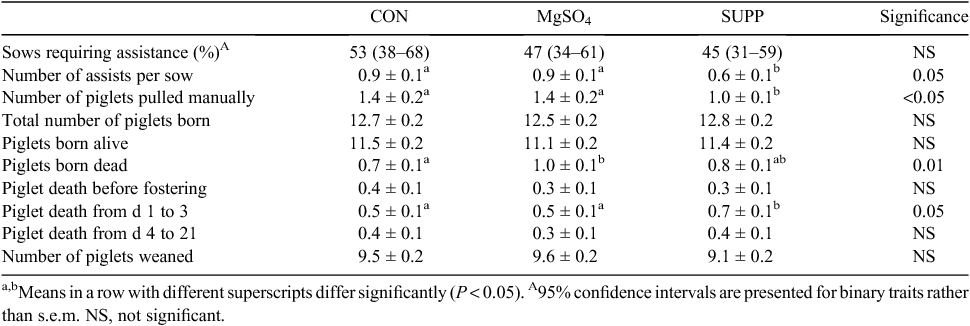Farrowing performance of sows with increased magnesium concentrations in a transition diet
K. J. Plush A C D , D. S. Lines C , J. S. Huser C , S. H. Hallett C and W. H. E. J. van Wettere BA Animal Welfare Science Centre, South Australian Research and Development Institute, Roseworthy, SA 5371.
B School and Animal and Veterinary Sciences, The University of Adelaide, Roseworthy, SA 5371.
C SunPork Solutions, Wasleys, SA 5400.
D Corresponding author. Email: kate.plush@sunporkfarms.com.au
Animal Production Science 57(12) 2446-2446 https://doi.org/10.1071/ANv57n12Ab102
Published: 20 November 2017
Around birth, sows are subject to factors that result in stress, such as confinement in a crate, the parturition process, a change in state from gestation to lactation, and constipation. These can all potentially reduce piglet survival and hence pigs weaned per sow. Magnesium reduces stress in finisher pigs (D’Souza et al. 1998), is a fetal neuroprotectant (Marret et al. 2007), and an effective laxative. We hypothesised that increased magnesium in a transition diet of the sow would improve farrowing performance and number of pigs weaned.
Sows (n = 811, parity 3.2 ± 0.1) were randomly allocated to treatment; CON fed lactation mash, MgSO4 fed lactation sow mash with added magnesium sulphate (2.85 kg/tonne), SUPP fed lactation mash mixed with an algae supplement high in magnesium and calcium (5.5% and 30% respectively; 5 kg/tonne). Sows were fed 2.5 kg of the treatment diets from 5 days prior, and ad libitum to 3 days after farrowing. From 4 days to weaning, all sows were fed the CON diet ad libitum. Sows that farrowed between 0700 and 1600 h were checked every 40 min and if no progression was noted, were manually assisted. Sows were fostered to 11.52 ± 0.03 piglets 12 to 24 h after farrowing, and where possible this was conducted within treatment. All data analyses were carried out in SPSS v24.0 (IBM, Armonk, NY, USA) with the number of times a sow was assisted, the number of piglets pulled manually and all piglet mortality using a generalised linear model with Poisson distribution, percentage of sows requiring assistance using a generalised linear model with binary distribution and total pigs born, pigs born alive and number of piglets weaned using a general linear model.
The percentage of sows requiring assistance was unchanged by treatment, but the number of sow assists, and number of piglets pulled manually were reduced in the SUPP treatment compared with CON and MgSO4 (P < 0.05; Table 1). Total piglets born, and piglets born alive did not differ, but number of piglets born dead increased in MgSO4 sows compared to CON (P = 0.01). More piglets died from d 1 to 3 in the SUPP treatment than CON (P = 0.05), but number of piglets weaned was similar for all treatments.
Although some small treatment differences were observed, the addition of two magnesium sources fed to sows during the transition phase from gestation to lactation did little to impact number of pigs weaned.
References
D’Souza DN, Warner RD, Leury BJ, Dunshea FR (1998) Journal of Animal Science 76, 104–109.| Crossref | GoogleScholarGoogle Scholar |
Marret S, Doyle LW, Crowther CA, Middleton P (2007) Seminars in Fetal & Neonatal Medicine 12, 311–317.
| Crossref | GoogleScholarGoogle Scholar |
Supported in part by Pork CRC Limited Australia and Feedworks Pty Ltd.



